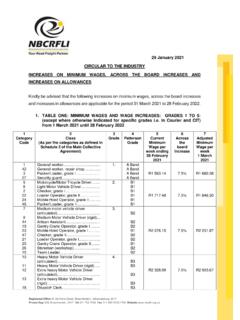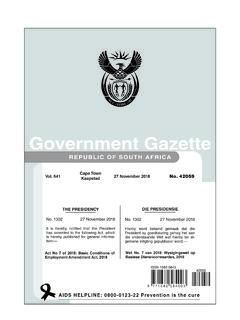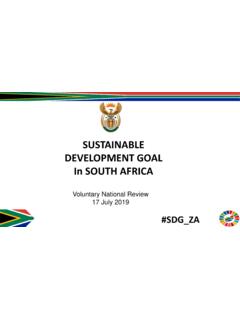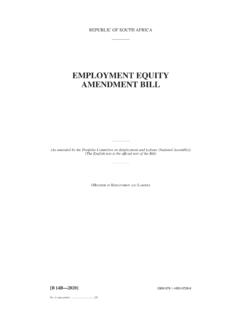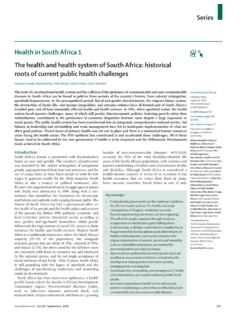Transcription of THE IMPACT OF FOREIGN DIRECT INVESTMENT ON WAGES …
1 Division for Employment Analysis and Policy, Directorate for Employment, Labour and Social Affairs Organisation for Economic Co-operation and Development 2 rue Andr -Pascal, Paris 75116, France OECD-ILO CONFERENCE ON CORPORATE SOCIAL RESPONSIBILITY Employment and Industrial Relations: Promoting Responsible Business Conduct in a Globalising Economy 23-24 June 2008, OECD Conference Centre, Paris, France THE IMPACT OF FOREIGN DIRECT INVESTMENT ON WAGES AND WORKING CONDITIONS This report serves as a background document to the OECD-ILO Conference on Corporate Social Responsibility. Its aim is to take stock of the current state of knowledge regarding the social IMPACT of inward FDI, especially on the WAGES and non-pay working conditions offered by MNEs in host countries. Any queries concerning the report should be addressed to Elena Arnal 2 TABLE OF CONTENTS THE IMPACT OF FOREIGN DIRECT INVESTMENT ON WAGES AND WORKING CONDITIONS.
2 3 1. Introduction .. 3 2. The growing importance of FDI .. 3 3. The IMPACT of FDI on employment conditions and industrial relations: a literature review .. 11 4. New OECD evidence on the effects of FDI in the FOREIGN affiliates of MNEs .. 16 5. Concluding remarks .. 25 ANNEX .. 27 References .. 29 3 THE IMPACT OF FOREIGN DIRECT INVESTMENT ON WAGES AND WORKING CONDITIONS 1. Introduction FOREIGN DIRECT INVESTMENT (FDI) is often seen as a driver for economic development as it may bring capital, technology, management know-how, jobs and access to new markets. Policy-makers have, therefore, tended to emphasize the benefits that FDI can bring to host economies, particularly in developing countries. Accordingly, many governments have developed policies to encourage inward FDI. While FDI and multinational enterprises (MNEs) are often perceived to be beneficial for local development, they have also aroused much controversy and social concerns.
3 For example, MNEs have often been accused of taking unfair advantage of low WAGES and weak labour standards in developing countries. MNEs also have been accused of violating human and labour rights in countries where governments fail to enforce such rights effectively. The aim of this paper is to take stock of the current state of knowledge regarding the social IMPACT of inward FDI in host countries, with particular emphasis on the WAGES and working conditions offered by OECD-based MNEs to their workforces in non-OECD countries. The paper also considers possible spillover effects of FDI on workers employed by local firms. The structure of the paper is as follows. Section 2 provides a description of the various trends in FDI during the past two decades in OECD and non-OECD countries.
4 Section 3 reviews the literature on the DIRECT and indirect IMPACT of FDI on WAGES and working conditions in host countries. Section 4 summarises the new empirical evidence carried out for Chapter 5 of the OECD Employment Outlook 2008, for two developing (Brazil and Indonesia) and three developed countries, Germany, Portugal and the United Kingdom, and Section 5 offers some concluding remarks. 1 2. The growing importance of FDI FDI has increased rapidly FOREIGN DIRECT INVESTMENT is defined as an INVESTMENT made to acquire a lasting interest by an entity resident in one economy in an enterprise resident in another economy. The INVESTMENT should allow the investing entity to exert DIRECT control over the management of assets in the invested firm. For statistical purposes, it is typically assumed that this is the case when a FOREIGN investor owns 10 percent or more of the ordinary shares of voting power (or the equivalent).
5 Investments that fall short of the 10% ownership threshold are classified as portfolio investments. 1 . Chapter 5 of the OECD Employment Outlook 2008, will be referred hereafter to as OECD (2008a) for convenience. 4 During recent decades, the importance of FDI in the world economy has increased The global stock of inward FDI as a percent of global GDP has increased from less than 5% in 1980 to 25% in 2006 (see Figure 1).3 The increase in FDI is largely driven by the ongoing liberalisation of trade and INVESTMENT and technological developments in information and communication technologies. Figure 1. World FOREIGN DIRECT INVESTMENT , 1980-2006 Global FDI stocks as a percentage of world GDPa 051015202530198019851990199520002005 Globa l stock of outwa rd FDIG loba l stock of inwa rd FDI a.
6 FDI stocks and world GDP are expressed in current US Dollars. Source : UNCTAD, FDI Statistics. The geographical distribution of FDI Although the bulk of FDI continues to take place between OECD countries, the relative importance of non-OECD countries for inward and outward FDI has grown substantially during the past 15 years, reflecting the integration of developing countries into the world economy, and particularly, of the so-called BRICs Brazil, China, India and Russia. Figure 2 shows that the share of non-OECD countries in the global 2 . UNCTAD provides the most comprehensive dataset on FDI stocks that is currently available in terms of both its coverage across countries and time. As such, it is the best data source for describing global trends in FDI.
7 As data on FDI was not available from national sources for all countries and years, UNCTAD imputed some values in order to be able to make globally representative estimates. In other instances, UNCTAD made certain statistical adjustments to the data that were provided from national sources in order to enhance their international comparability. For both these reasons, FDI estimates based on UNCTAD may be different from those based on FDI data provided by either the OECD or the IMF (cf. OECD FDI Statistics and IMF Balance of Payment Statistics). See OECD (2008b) for a detailed discussion of international methodological standards for the measurement of FOREIGN DIRECT INVESTMENT . 3 . The global outward stock of FDI follows a similar trend. While, in principle, the global stocks of inward and outward FDI should be equal at all times, in practice, sizable discrepancies tend to exist.
8 This is largely due to gaps in coverage and the use of different reporting systems across countries (Patterson et al., 2004). 5 stock of inward FDI has risen from 22% in 1990 to 32% in 2005 and their share in the global stock of outward FDI from 10% in 1990 to 17% in 2005. The rising importance of non-OECD countries as a destination for FDI has a number of potential implications. First, since the mid-1990s FDI has become the most important source of external finance for developing countries, thus reinforcing its potential role for the development process in those countries (see Figure in Annex)4. Second, the increasing number of potential destinations for FDI and the growing dependence of developing countries on FDI has intensified competition among countries to attract FDI.
9 But, the rise in FDI from OECD countries into non-OECD countries has also raised serious social concerns about poor labour practices in the FOREIGN operations of MNEs originating from OECD countries. This is particularly the case as minimum labour standards are not always effectively enforced in such countries. Figure 2. Trends in FOREIGN DIRECT INVESTMENT by groups of countries, 1990-2005 Billions of US dollars at constant prices (2000) Non-OECD countriesOECD countriesaA. Inward FDIB. Outward b. Corresponds to the 30 OECD member countries. Source : OECD (2008a). Figure 3 focuses on the trend in inward and outward FDI for key emerging economies (Brazil, Chile, China, India, Indonesia, Russian Federation and south africa ). Panel A documents FDI for these countries with respect to the rest of the world, while Panels B and C show their FDI stocks from and to, respectively, OECD and non-OECD countries.
10 In all seven countries, inward and outward FDI has tended to increase significantly between 1990 and 2005. China, mainland plus Hong Kong, is by far the most important non-OECD country both as a source and as a recipient of FDI. In 2005, China represented more than a third of the total inward FDI of all non-OECD countries, and more than half of outward FDI. This trend has consolidated China as a growing source of FDI, reaching in 2006 the 4th world position in terms of stocks and the 6th in terms of 4 . However, the relative importance of FDI as a source of external finance differs substantially across regions. For example, in Sub-Saharan africa , aid is more important than FDI (World Bank, 2006). 5 . When distinguishing between mainland China and Hong Kong, one observes that Hong Kong is much more important for both inward and outward FDI than is mainland China.












